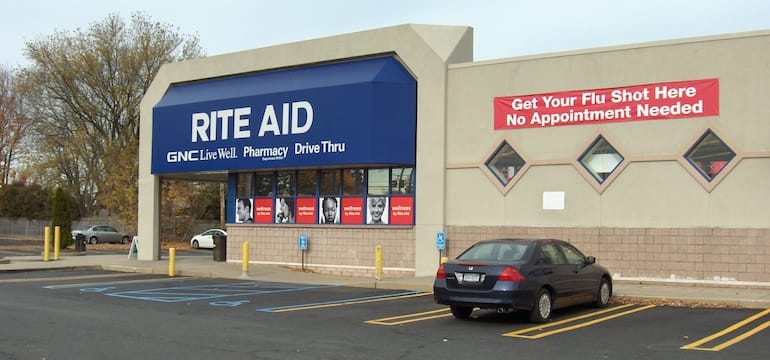CAMP HILL, Pa. — Rite Aid Corp. on Thursday reported net income of $767.1 million, or 73 cents per diluted share, for the fourth quarter ended March 3. The company showed a net loss from continuing operations of $483.7 million, or 46 cents per diluted share, for the quarter. Adjusted net loss from continuing operations was $10.3 million, or 1 cent per diluted share, adjusted EBITDA (earnings before interest, taxes, depreciation and amortization) from continuing operations was $157.4 million, or 2.9% of revenues, and pro-forma adjusted EBITDA from continuing operations was $173.2 million.

Net income for the full year was $943.5 million, or 90 cents per diluted share. Fourth quarter and full-year net income include an after-tax gain of around $1.2 billion and $1.3 billion, respectively, related to the sale to Walgreens Boots Alliance (WBA) of 1,554 stores in the quarter and 1,651 stores during the full year. As of March 27, Rite Aid had completed the sale of all 1,932 stores and related assets to WBA included in the deal. The transfer of the three distribution centers and related inventory is expected to begin after September 1 this year. As a result of the proceeds received from the store sales, Rite Aid’s debt related to continuing operations, net of cash, was $2.9 billion as of March 3.

John Standley
“During the fourth quarter, we made significant progress in a number of areas: Our Retail Pharmacy Segment delivered strong results, with an increase in adjusted EBITDA over the prior year; our Pharmacy Services Segment is off to a strong start in the new commercial selling season; shortly after the quarter ended, we completed the asset sale of 1,932 stores to WBA; and we entered into a definitive merger agreement with Albertsons Cos. to transform Rite Aid into a truly differentiated leader in food, health and wellness,” Rite Aid chairman and chief executive officer John Standley said in a statement.
“We are pleased that we’ve been able to drive improved operational performance through a stabilization of reimbursement rates, improvements in drug purchasing costs and a record number of immunizations which helped us deliver a higher pharmacy margin for the quarter,” Rite Aid president and chief operating officer Kermit Crawford added. “These areas of our business will continue to be key priorities as we begin our new fiscal year and work together to continue building momentum.”
Revenues from continuing operations for the quarter were $5.4 billion compared to revenues from continuing operations of $5.9 billion in the prior year’s fourth quarter, a decrease of $509.1 million, or 8.6%. Retail Pharmacy Segment revenues were $4.0 billion and decreased 10.1% compared to the prior-year period, primarily as a result of the extra week in the prior year’s fourth quarter and a decline in same-store sales. Revenues in the Pharmacy Services Segment were $1.4 billion, a decrease of 4.3% compared to the prior-year period, which was due to a decline in commercial business and changes in the composition of Rite Aid’s Medicare Part D membership.
Same-store sales from Retail Pharmacy continuing operations for the quarter decreased 1.7% over the prior year, consisting of a 2.3% decrease in pharmacy sales and a 0.6% decrease in front-end sales. Pharmacy sales include an approximate 138-basis-point negative impact from new generic introductions. The number of prescriptions filled in same stores, adjusted to 30-day equivalents, decreased 1.8% over the prior-year period due in part to exclusion from certain pharmacy networks in which Rite Aid participated in the prior year. Prescription sales from continuing operations accounted for 64.9% of total drug store sales.
In the fourth quarter, the company relocated six stores and remodeled 38 stores, bringing the total number of Wellness stores chainwide to 1,805. Along with selling the 1,554 stores to WBA during the quarter Rite Aid closed 19 stores, resulting in a total store count of 2,831 at the end of the period. Wellness store count and total store count related to continuing operations was 1,651 and 2,550, respectively.
Rite Aid confirmed its fiscal 2019 outlook for adjusted EBITDA and net loss and provided its fiscal 2019 outlook for revenues, same-store sales, capital expenditures and adjusted net income. The company’s outlook for fiscal 2019 is based on the anticipated benefits from generic drug purchasing efficiencies, a reimbursement rate environment that is somewhat more stable than fiscal 2018, TSA (transition services agreement) fees under the deal with WBA, and other initiatives to grow sales and drive operational efficiencies.
The retailer said it expects sales to be between $21.7 billion and $22.1 billion in fiscal 2019 with same store sales expected to range from an increase of 0.0 percent to an increase of 1.0% over fiscal 2018.Adjusted EBITDA is expected to be between $615.0 million and $675.0 million.
Net loss is expected to be between $40.0 million and $95.0 million. Adjusted net income per diluted share is expected to be between $0.02 and $0.06. Capital expenditures are expected to be approximately $250 million.
The outlook does not reflect the impact of the pending merger of Rite Aid with Albertsons Cos., announced in February. The boards of directors of both companies have approved the transaction, and the waiting period under the Hart-Scott-Rodino Antitrust Improvements Act of 1976, as amended, has expired. The merger is expected to close early in the second half of calendar year 2018, subject to the approval of Rite Aid’s shareholders, regulatory approvals and other customary closing conditions.









